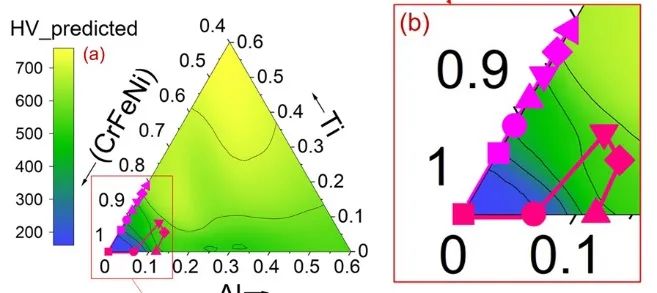海归学者发起的公益学术平台
分享信息,整合资源
交流学术,偶尔风月

由四种或四种以上元素组成的多主元素合金具有巨大的组分空间和复杂的相互作用,因而难以用现有的物理模型进行精确诠释或预测,这也给研究者带来了的挑战。第一性原理计算能够准确预测零温下多主元素合金的相稳定性、硬度等物理性质,但在有限温度下实现性能的预测则相当耗时。同时,相关的实验探索也同样因为组分空间庞大而非常昂贵。考虑到这些限制因素,再加上近十年来积累的大量有关多主元素合金的数据,基于机器学习的方法迅速受到了人们的关注。然而,机器学习方法存在一个典型的缺陷,即物理上可解释的少参数模型达不到精度要求,而高精度的多参数模型又缺乏物理可诠释性。
来自印度理工学院冶金与材料工程系的D. Beniwal等人,提出了一种机器学习策略,可以通过单元素与合金描述符来驱动人造神经网络集合,从而实现多主元素合金硬度的快速预测和探索。作者使用密度泛函理论计算了合金体系的总能量和电子结构,应用热力学线性响应理论分析了系统的化学短程序,揭示了体系的相稳定性、电子效应和短程序/团簇等物理机制与机器学习方法预测硬度之间的关系。为深入理解决策过程,作者开发了一种使用局部偏依赖关系和刺激-响应特征的机器学习模型,并通过预测原子间相互作用(如形成焓和键合特性)、局部晶格畸变(如尺寸不对称、弹性焓和应变能)以及相分类,实现了机器学习模型的解码,成功揭示了该模型如何利用不同特征进行硬度物理起源的捕捉。该工作提出的机器学习框架能够有效探索多主元素合金广阔的组分空间,解码方法也可以扩展到任意机器学习模型中,因而有助于加深对现有以及未来机器学习模型的基本理解。
该文近期发表于npj Computational Materials 8:153(2022),英文标题与摘要如下,点击左下角“阅读原文”可以自由获取论文PDF。

Distilling physical origins of hardness in multi-principal element alloys directly from ensemble neural network models
D. Beniwal, P. Singh, S. Gupta, M. J. Kramer, D. D. Johnson & P. K. Ray
npj Computational Materials 8: 153 (2022).
Despite a plethora of data being generated on the mechanical behavior of multi-principal element alloys, a systematic assessment remains inaccessible via Edisonian approaches. We approach this challenge by considering the specific case of alloy hardness, and present a machine-learning framework that captures the essential physical features contributing to hardness and allows high-throughput exploration of multi-dimensional compositional space. The model, tested on diverse datasets, was used to explore and successfully predict hardness in AlxTiy(CrFeNi)1-x-y, HfxCoy(CrFeNi)1-x-y and Alx(TiZrHf)1-x systems supported by data from density-functional theory predicted phase stability and ordering behavior. The experimental validation of hardness was done on TiZrHfAlx. The selected systems pose diverse challenges due to the presence of ordering and clustering pairs, as well as vacancy-stabilized novel structures. We also present a detailed model analysis that integrates local partial-dependencies with a compositional-stimulus and model-response study to derive material-specific insights from the decision-making process.
